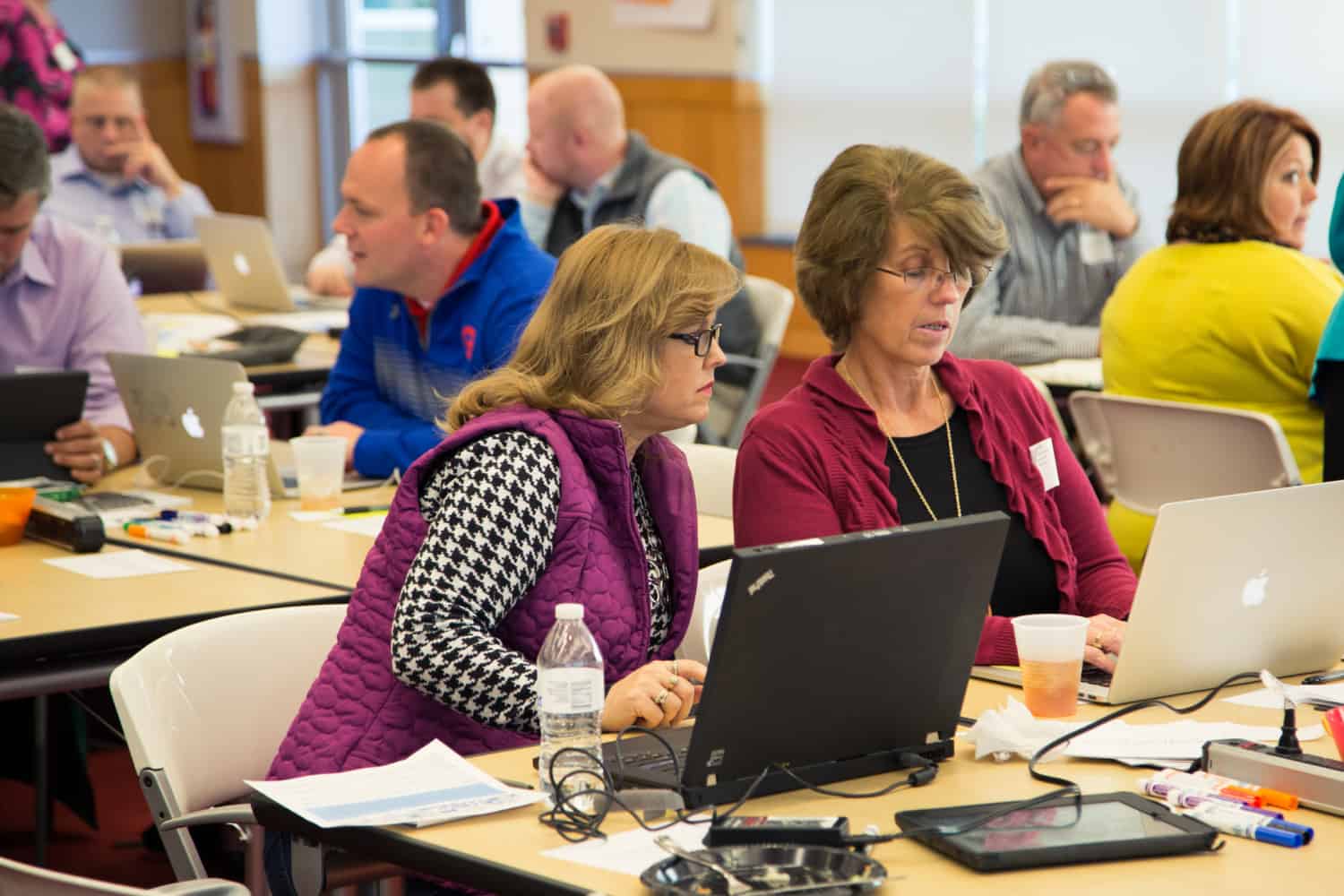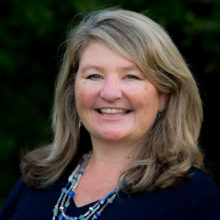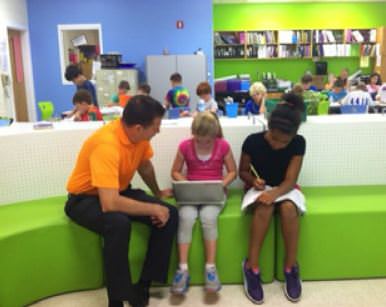Principal learning cannot stop with earning an administration certificate or a degree. Like teachers, principals must have access to ongoing and job-embedded professional learning that is relevant for their context and personalized needs. Principals typically have fewer opportunities than teachers to take time to learn.
Stephen Gay, Principal at East Wake Academy in Zebulon, reflects that “Often, as principals, we get stuck in the day to day aspects of our jobs, and this just snowballs and keeps us from taking the time to reflect, process, and ‘feed’ our own learning. Job-embedded practice allows us the real life tools that can be mobilized in our schools and pushes us to drive positive change in our buildings.”
LaChawn Smith, Assistant Superintendent of Instruction and Academic Accountability in New Hanover County Schools, sees that, “Too often, good intentions are not enough. Frequently, traditional professional development requires that we rely on good intentions to take what we have learned and make changes in our practices. Job-embedded professional development helps to ensure that what principals learn is grounded in their day-to-day work in schools and to create opportunities for collaborative and active learning with their teachers and peers.”
EdNC’s School Leadership Series has shared great perspectives and examples about the importance of the role of the principal and also the essential focus on preparation. Like with teachers, professional learning cannot stop with pre-service. In our state, we have over 2,400 principals in public schools alone. In the best case scenario, aspiring principals have the opportunity to participate in high quality, job-embedded preparation programs. These principals have myriad responsibilities and face many challenges, and many do not know where to turn for support, new learning, or even one-on-one brainstorming or reflection. These leaders almost always assume their positions in schools that are working to transform teaching and learning — and most are at some point in the process of beginning or leading their schools in the transition to personalized and digital learning.
When you ask principals about where they are able to access ongoing professional learning, you will likely hear that they have very few choices. Even those who find opportunities or build a professional learning network via Twitter or social media rarely have the financial flexibility or support to participate in robust programs.
Mary Brown, Principal of Wittenberg Elementary School in Alexander County Schools, says that, “Successful principals are models of lifelong learning. If we do not understand the skills, knowledge, and experiences necessary for success after K-12 education, we are not fulfilling our obligation to our students and teachers. We need to know what is happening outside our school and our district so we can develop the best vision for our school and students.”
North Carolina is somewhat unique in its efforts to tackle this need, and the state leaders understand the importance of professional learning for district and school leaders. The NC Digital Learning Plan placed an important emphasis on ensuring that many more of our leaders in district offices and schools would have the chance to grow their capacity to lead the transition to digital learning and recommended that the state, “Provide professional development for school and district leaders, instructional support staff, and technical staff, in order to prepare local leadership teams to plan and implement successful digital learning initiatives.”1 This summer, the legislature provided funding for the state to provide access to district and school leaders, and in December three cohorts of principals began meeting online and in face-to-face sessions in the western, central, and eastern parts of the state to bring the learning closer to districts.
Over 120 principals from 54 districts have now begun the journey in the NC Leadership in Blended and Digital Learning Program (NCLBDL) led by the Friday Institute for Educational Innovation in partnership with the NC Principal & Assistant Principals’ Association (NCPAPA) and the NC Department of Public Instruction (NCDPI). The principal cohorts build upon the Distinguished Leadership in Practice for Digital Learning (DLP-DL), initially created by the NCPAPA and the Friday Institute with funding from DPI through Race to the Top, and a national adaption of the program created by the Friday Institute and funded by The Learning Accelerator. While DLP-DL engaged approximately 100 principals in 2014 and 2015, funding was not available to continue, and the principals in our state did not have other options until the legislature responded in the summer of 2016.
The NCLBDL program models personalized learning through ongoing, job-embedded experiences with face-to-face and online learning opportunities. Mary Brown, a DLP-DL graduate, thinks that, “The most important outcome for my school was to develop a digital learning leader identity. This identity has given me and my teachers an advantage in understanding and realizing some of the potential of digital learning. They are more open and more comfortable with digital devices and applications because we strive to continuously improve our knowledge and instruction in this area…One important distinction is that my teachers use the technology immediately. The more important distinction is that students are using technology not as a replacement, but to communicate, collaborate and create. This is not the case in all schools. For example, worksheets on a Chromebook are still worksheets. Interactive informational posters researched and developed by teams of students in google slides are creations.”
Kent Parent, Principal at Balfour Education Center in Henderson County Public Schools, emphasizes the importance of professional learning so that principals can model what they expect of teachers and students. “I recommend that the principal and administrative leadership team lead by example and through demonstration. An example is establishing an information platform such as Google Classroom to communicate with staff, forcing teachers to use the digital platform from the student experience… The principal and admin team must be diligent and refrain from the mass email communications, forcing staff to begin the digital experience from a student’s perspective.”
Mr. Gay added that, “The DLP-DL helped us see what we can accomplish, while also realizing that everyone is not at the same place in implementing change. The core framework helps us visualize the future and to mold the experience to fit our school’s need.” These principals continue to share what they have learned and meet-up across the state, and even open up their schools for other leaders to visit. Robin Calcutt, Director of Accountability, Planning, and Research in Moore County Schools, shares how her experience in DLP-DL while she was a principal and, now, the experience of more principals from Moore County, continues to build her district’s capacity:
“Principals are the instructional leaders of their schools, but they also have many other responsibilities that demand their time and attention. The opportunity to receive the high-quality, professional learning and coaching of the DLP-DL was invaluable to me and our Principals in Moore County [now through NCLBDL]. Not only did I develop a deeper understanding of the steps required to support a digital learning initiative in my school, but I value the connections that I made to other school leaders across the state.”
The principals in NCLBDL focus on several critical aspects of leading schools in the transition to personalized and digital learning. The fundamental aspects of leadership hold strong, and the leaders also explore how personalized and digital learning may place additional demands on them and their teachers and students. The program also helps the principals build capacity for the new Digital Learning Competencies for Administrators being implemented across the state. Key components include:
- Vision, Leadership, and Culture for moving to teaching and learning that is student-centered, including a culture that encourages a growth mindset and risk-taking
- Curriculum & Instruction, including frameworks for digital learning and student-centered learning
- Professional Learning that is job-embedded, ongoing, and personalized, and maximizes the potential of coaches, media coordinators, and teacher leaders
- Technology & Infrastructure that supports the vision for teaching and learning, rather than being separate or on the side
- Data & Assessment, including consideration for having just-in-time data that informs instruction and utilizing alternative assessments to provide students with multiple ways to demonstrate learning
- Planning for the Transition, including the development of a roadmap, engagement of stakeholders throughout the process, and an approach to continuous improvement
One of the principals from the new NCLBDL cohorts shared that, “It helped us start thinking about a way to begin the organization of this process. We have been conducting certain elements of [digital and blended learning] in various classrooms with different degrees of personalization…but planning helped us become more concrete about our plan and vision. Also going over data from the survey [of our teachers] helped us look at certain things we may need to address to make sure all staff are on the same page, in particular with our school vision and its use of technology to assist in personalizing learning.”
Mary Brown explains how this comprehensive approach has allowed her to move more effectively in this transition. Ms. Brown has worked with her team to transform her library to a student-centered makerspace. She also emphasizes that, “Principals needs to be the leader and the model. Teachers have to have time to get comfortable with the technology before they are evaluated using it. My teachers observe each other using different technology before I ever observe them. Also, ask them what professional development they need. Finally, celebrate them and their students with a shout out or a digital learning day. Ask their advice and use their expertise. DLP-DL has been one of the best professional development experiences of my career because it helped me to understand where I need to lead my staff and students.”
Ms. Calcutt, who has now moved into a district leadership role, emphasizes that “Digital learning constantly changes with tools, instructional strategies, and collaborations among a variety of school teams. Our schools have established digital norms, an enthusiastic response by teachers and students for an online learning platform (Canvas), and we are moving towards increasing 21st century knowledge using the 4Cs (critical thinking, communication, collaboration, creativity) embedded within our instructional practices. We found that learning became intergenerational, meaning that now we view every member (superintendent to kindergartner) of our school district as a learner. We think differently about how people learn and do our best to engage them within the learning experience.”
This professional learning experience does not end after graduation. Participants from these cohorts have created an informal Alumni Network, and principals from the new NCLBDL cohorts that started this year will join them in their ongoing collaboration. Ms. Calcutt has some additional advice for principals: “My advice for new principals experiencing this transition is to truly listen to his/her community; think deeply about the effects/opportunities that will occur; realize that everything will not be ‘perfect’ but to see any ‘redos’ as an opportunity to learn and grow. Do your best to make connections for people — help them to see the benefits, connect them with support (PD, facilitators, resources) and to enjoy every minute of this exciting time in which ‘learning’ expands to a whole new level.”
Perhaps the most important lesson for principals is realizing that school leaders across the state and country are often in the same boat as them. Mr. Gay adds, “Change will not happen overnight! The change is a process and can be different in each school (stakeholders), but take what you learned at the FI and apply it to your situation, but most of all:
“You are not alone!”



